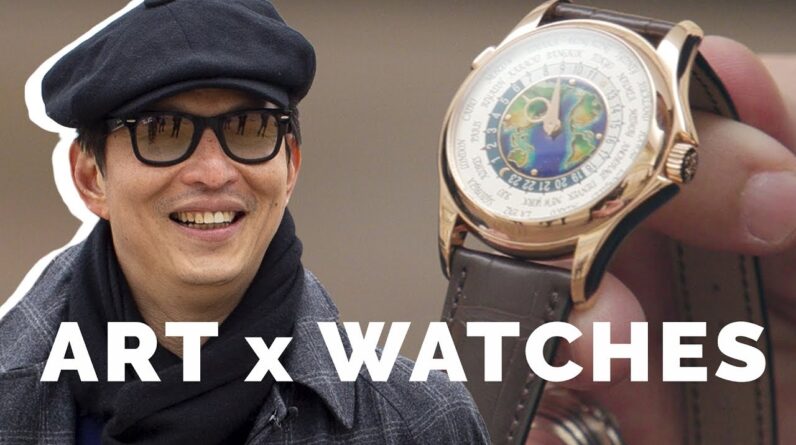
In the video by WatchBox Studios, Wei Koh, the founder of Revolution Magazine and The Rake, explores the impact of technology on art and watches, with a particular focus on post-quartz watches. Koh and Tim Mosso take a deep dive into the culture of Philadelphia and draw intriguing parallels between fine art and watches. They visit the Barnes Foundation, which houses an impressive collection of over 4,000 pieces, including 900 paintings, valued at $25 billion. The discussion touches on the influence of photography and the democratization of reality, as well as the democratization of accuracy brought about by quartz watches. Post-quartz watches from brands such as MB&F, FP Journe, Patek Philippe, and Greubel Forsey are showcased as examples of watches that defy the changes of the quartz era by appealing to emotions. The video concludes with a curated watch collection by Tim Mosso, who joins a discussion with Wei Koh on the intersection of watches and art. The content also explores the obsolescence of electronic devices and the enduring value of traditional watchmaking, with a focus on the exquisite minute repeater watches by Patek Philippe.
Table of Contents
The Influence of Technology on Art and Watches
In a video by WatchBox Studios, Wei Koh, founder of Revolution Magazine and The Rake, discusses the influence of technology on art and watches. He explores the parallels between fine art and watches, focusing on the culture of Philadelphia and the renowned Barnes Foundation art collection. Koh also delves into the impact of technology, specifically the introduction of photography and Quartz watches, on both art and the watch industry.
Parallelism between Fine Art and Watches
Koh and Tim Mosso, in their discussion on the parallels between fine art and watches, shed light on the rich culture of Philadelphia and its connection to the world of art. The Barnes Foundation, with its collection of 4000 pieces, including 900 paintings, is a significant repository of impressionist, post-impressionist, and modernist art. The value of this collection is estimated to be around $25 billion.
The Era before and after the Camera in Art and Watchmaking
Koh draws parallels between the era before the camera in art and watchmaking. Before the camera, representing reality was the primary focus of artists and watchmakers alike. The camera’s introduction marked a shift towards emotional expression in art, with impressionism emerging as the first major movement of this era. Similarly, watchmaking before Quartz watches was all about accuracy and precision.
Post-Quartz Watches Defying the Changes
Koh highlights post-quartz watches from brands such as MB&F, FP Journe, Patek Philippe, and Greubel Forsey as examples that defy the changes brought about by Quartz watches. These watches appeal to emotions and incorporate emotional expression into their designs and mechanisms. For example, MB&F watches blur the line between art and horology, while Patek Philippe’s world time enamel watches showcase the emotional beauty of different time zones.

Curating a Watch Collection
Tim Mosso takes the viewers through the process of curating a watch collection. This discussion sheds light on the thought and consideration that goes into selecting watches that align with one’s personal taste and style. Mosso emphasizes the importance of emotional connection and enjoyment when curating a watch collection.
The Barnes Foundation and Albert C. Barnes’ Collection
The Barnes Foundation is a renowned institution that houses Albert C. Barnes’ collection of impressionist, post-impressionist, and modernist art. With over 4,000 pieces on display, including 900 paintings, the collection is of immense value, estimated to be around $25 billion. The foundation serves as a testament to Barnes’ love for art and his dedication to preserving and sharing these masterpieces with the world.
The Parallels between Art and Watchmaking
Just as there are parallels between different eras in art and watchmaking, there are also parallels between the artistic expressions found in these two fields. The era before the camera, focused on representing reality, mirrors the era before Quartz watches, where accuracy was at the forefront. Meanwhile, the era after the camera, emphasizing emotional expression in art, aligns with the emotional expressions found in post-Quartz watches.
Emotional Expression in Watchmaking
Koh explores examples of emotional expression in watches, showcasing the work of brands such as M.B&F, Paul Gerber, and Patek Philippe. M.B&F watches, like the ones designed by Max Büsser, defy traditional horological design, blending artistic elements with intricate timekeeping mechanisms. Paul Gerber’s unique creations push the boundaries of watchmaking, incorporating bold colors and unconventional designs. Patek Philippe’s world time enamel watches evoke emotions through their depiction of different time zones, combining artistry and functionality.
Obsolescence of Electronic Devices vs. Traditional Watchmaking
As technology rapidly evolves, electronic devices often become obsolete, losing their value and usefulness over time. However, traditional watchmaking stands the test of time, with watches holding lasting value and significance. The craftsmanship and artistry involved in traditional watchmaking contribute to their enduring appeal and cultural significance.
The Allure of Minute Repeater Watches
Minute repeater watches, especially those made by Patek Philippe, are considered the best in the world. These watches chime the time on demand, often using complex mechanisms to produce beautiful melodies. The intricate craftsmanship and attention to detail required to create minute repeater watches contribute to their allure and desirability among watch enthusiasts.
Conclusion
In conclusion, the influence of technology on art and watches is a fascinating topic, explored by Wei Koh and Tim Mosso in their discussion. Both art and watchmaking have experienced shifts due to technological advancements, allowing for new forms of expression and functionality. Post-quartz watches have defied the changes brought about by Quartz technology, appealing to emotions and showcasing the artistry of watchmaking. The Barnes Foundation serves as a testament to the value and beauty of art, while traditional watchmaking continues to hold its lasting value and allure. Appreciating the value of traditional watchmaking and recognizing the emotional enjoyment and charm of post-quartz watches is key to fully understanding the impact of technology on art and watches.
